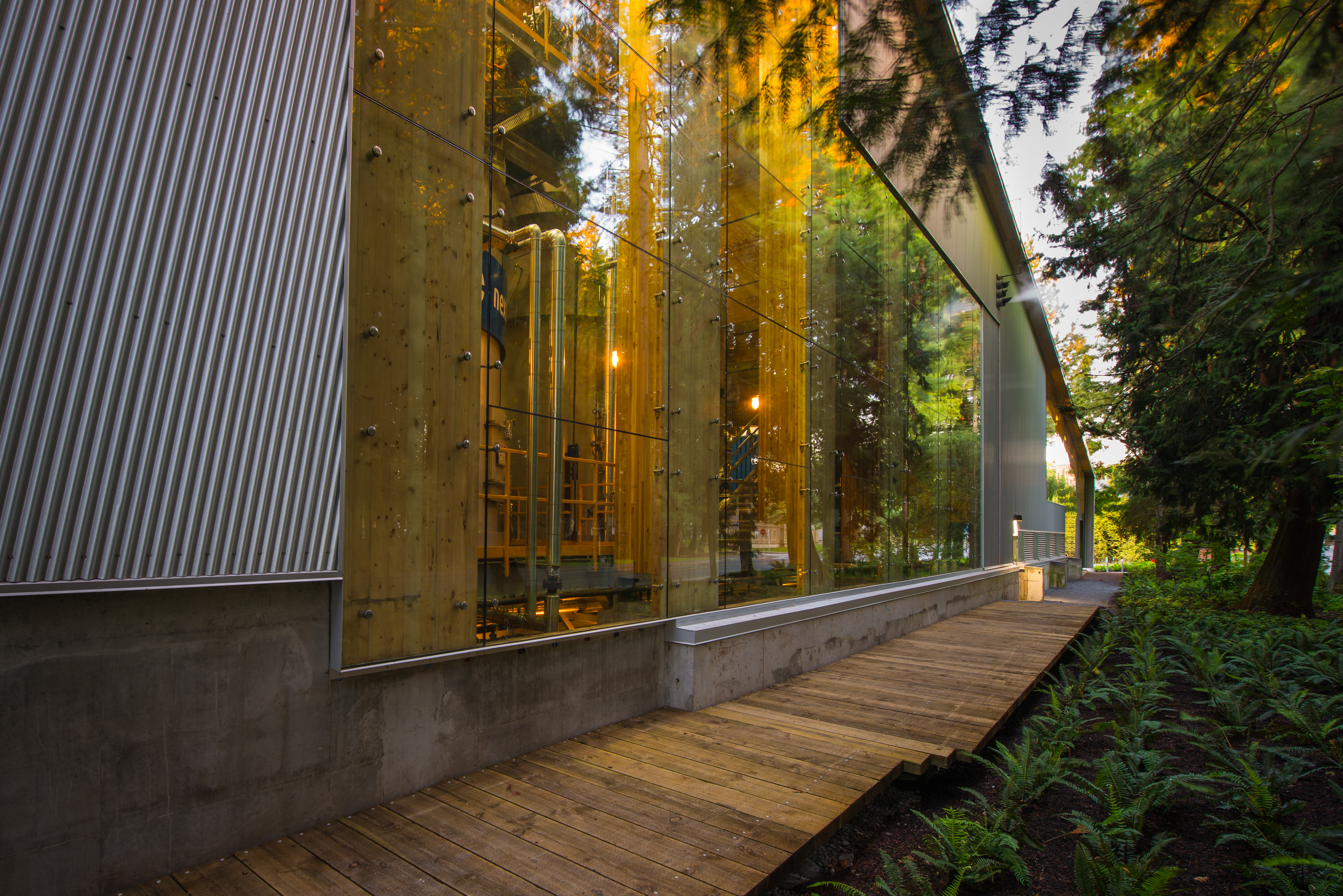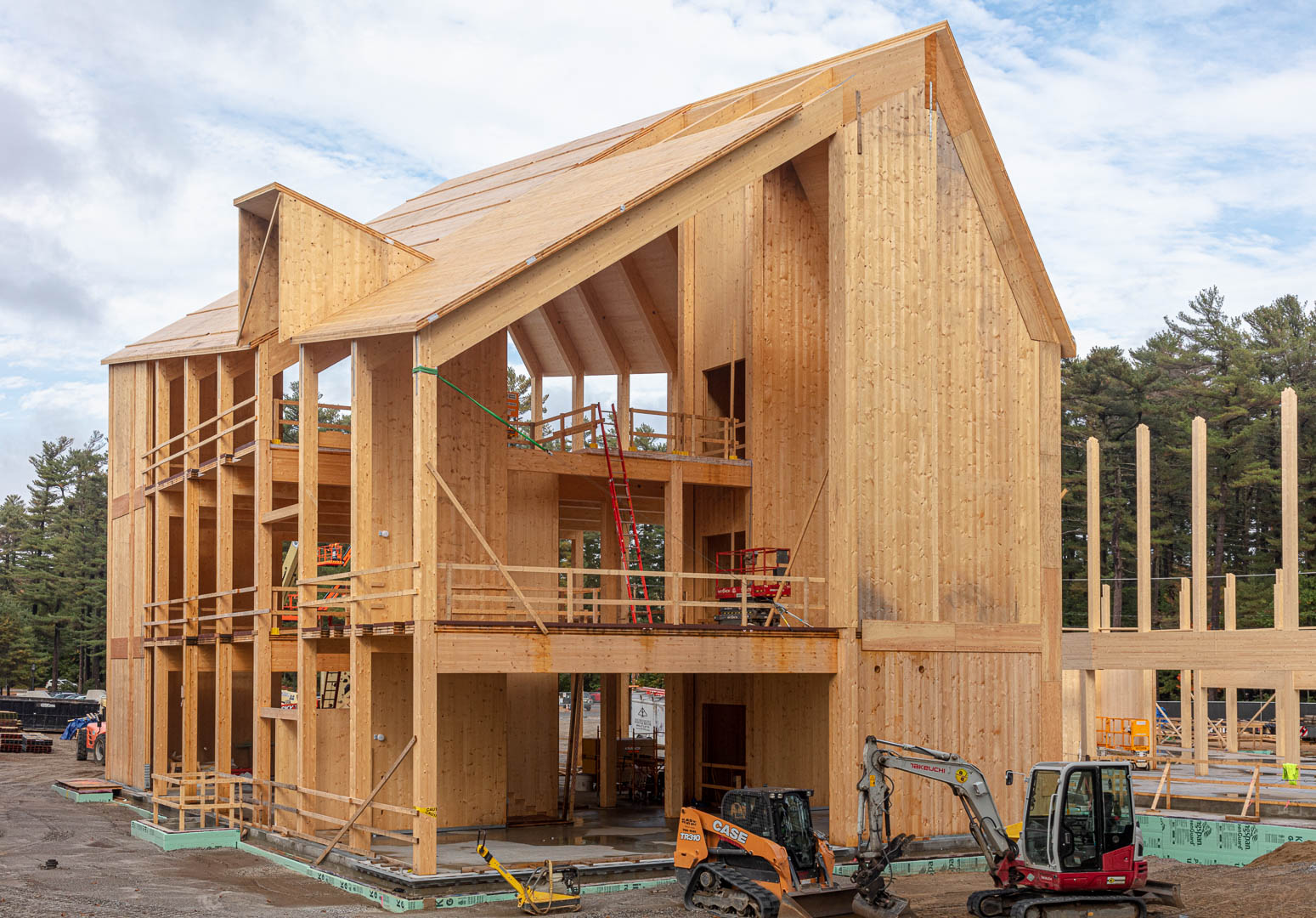Leer en español: Futuros edificios climáticamente inteligentes
Can buildings be not only energy efficient but also “climate smart”?
Technologies using wood can play a significant role in climate mitigation. Some are in various stages of the research and development process, some on the cusp of commercialization, and some are in the commercial growth phase. There is one technology being deployed by builders worldwide that’s creating a lot of buzz though. It’s called cross laminated timber (CLT) and is also known as mass timber.
What is CLT?
“Cross-laminated timber (CLT) panels consist of several layers of lumber boards stacked crosswise (typically at 90 degrees) and glued together on their wide faces and, sometimes, on the narrow faces as well. Besides gluing, nails, screws, or wooden dowels can be used to attach the layers.” [Canadian CLT Handbook]
Think of CLT panels as giant “wood sandwiches.” They can be more than a foot thick with lengths upwards of 50 feet! The panels are produced by automated equipment that glues pieces together and squeezes them until dry. Other specialized machines cut out places in the panels for windows and doors and holes and channels for electrical and gas lines. Once completed in the factory, the panels can be directly transported to construction sites where cranes lift and secure them into place. Each year as CLT technical knowledge and familiarity increases, the size of CLT buildings increases as well. An apartment complex in Milwaukee, called Ascent, will be 25 stories tall when completed in 2022, the tallest CLT building in the U.S so far.
CLT History and Development
European governments began actively engaging on the topic of greenhouse gas reductions over 30 years ago. It was clear even back then that building industries needed to develop ways to reduce their greenhouse gas emissions. Architects, builders, and allied industries worked to developed CLT technology in the 1990s. More recently, building with CLT has started to catch on in the U.S. and Canada. Today, many countries around the world are vying for the tallest building made from CLT.
In this Ted Talk, Canadian architect, Michael Green speaks further on the topic of mass timber (ie. CLT) and on why he finds building with wood so important and inspiring.
CLT as a Greenhouse Gas Reduction Strategy
Growing trees sequester carbon in wood, keeping carbon dioxide out of the atmosphere. Wood is about 50% carbon by weight. A building built with CLT “locks up” carbon for the life of the building. Large multi-story buildings are typically built from concrete and steel. Unfortunately, the production of concrete and steel results in significant carbon dioxide emissions without the added benefit of carbon sequestration.
[Globally] “The buildings and construction sector accounted for ~39% of energy and process-related carbon dioxide (CO2) emissions in 2018, 11% of which resulted from manufacturing building materials and products such as steel, cement and glass1.”
While CLT construction does not eliminate all concrete and steel use in building construction, it reduces the amounts of those carbon intense-materials. Concrete and steel are used in CLT construction when high load bearing capacity is critical. However, reduced use of concrete and steel in buildings can help lower greenhouse gas emissions associated with construction.

CAPTION: UBC's Bioenergy Research & Demonstration Facility uses cross-laminated timber throughout the building. Comparisons of the greenhouse gas footprints of CLT buildings versus similar buildings made of concrete and steel typically demonstrate the carbon mitigation benefits of CLT construction.2,3,4,5 | Photo by Don Erhardt
Building Interest in CLT
In January 2019, the International Code Council (ICC) approved a set of proposals to allow tall wood buildings as part of the 2021 International Building Code (IBC). As with anything new, there is a spectrum of acceptance; from those that are quick to adopt new ideas to others that are more hesitant to change current practices. For those inclined to consider something new, there are significant reasons to carefully consider CLT. Some of these include:
- Environmental attributes: The building and construction sector is a major contributor to greenhouse gas emissions worldwide. Concern for climate change is increasing. Because of these two factors, CLT is attractive by virtue of its lower carbon footprint. Someday a “carbon fee” may be attached to building materials. If that happens, then lower carbon options may have further economic implications.
- Reduced labor: CLT buildings are built in an ‘erector set’ fashion. This method dramatically reduces the amount of labor required to erect a building. This is a significant motivator for many builders as labor shortages have been a challenge in construction trades for some time.
- Visual appeal: CLT buildings featuring exposed wood can be aesthetically pleasing.
- Builder and designer interest: There has been rapidly growing interest in CLT from the architecture community.
- Consumer demand: There is strong consumer demand for environmentally conscious housing alternatives.

CAPTION: Bowdoin College’s latest construction project for Barry Mills Hall (scheduled to be open spring 2023) uses CLT panels. | Photo by Paul VanDerWerf
What USDA and the U.S. Forest Service are Doing to Support CLT Development
For the last several years, the U.S. Forest Service has supported Woodworks, an industry/government partnership focused on training architects and engineers in the use of CLT. Woodworks also works closely with partners to address barriers to CLT adoption and use. Research conducted by the U.S. Forest Service, Forest Products Lab has investigated the fire resistance of CLT, confirming that both protected and exposed CLT performs well. Support has also been provided by the Forest Service for mass timber design competitions:
“…the $2 million competition seeks to ‘showcase mass timber’s innovative applications in architectural design and highlight its significant role in reducing the carbon footprint of the built environment;’ project grants of up to $500,000 will be awarded to multiple project teams. The funds will enable the winning project teams to design and build repeatable and scalable mass timber buildings.”
In Closing
Switching from steel and concrete construction to include more CLT has major economic implications. Construction industries are also investing heavily in reducing the carbon footprints of concrete and steel. The success or failure of these industries to reduce carbon footprints may also influence the development of CLT. So far, it appears likely that CLT construction will prosper in the years and decades to come based on its’ capacity to cut emissions and “lock up” carbon.
1 Note that is the energy to produce the materials, build the building and energy to heat and cool.
2 Comparative Life-Cycle Assessment of a Mass Timber Building and Concrete Alternative
3 Platte Fifteen Life Cycle Assessment
4 A Comparative Life Cycle Assessment of Two Multistory Residential Buildings: Cross-Laminated Timber vs. Concrete Slab and Column with Light Gauge Steel Walls
5 Whole-life embodied carbon in multistory buildings: Steel, concrete and timber structures




